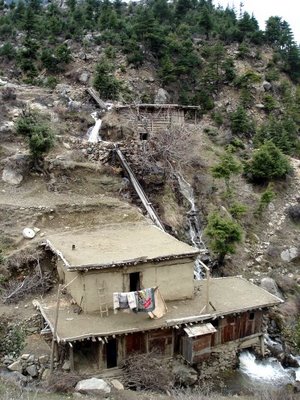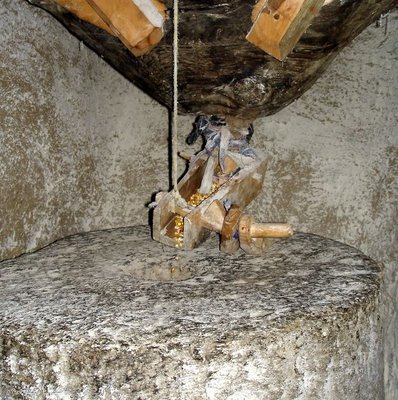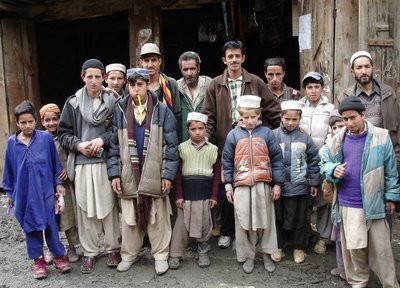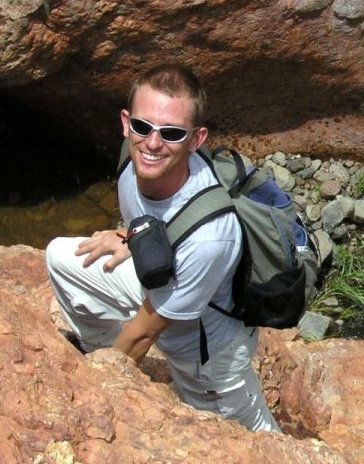It seems simultaneously unsurprising and amazing that a mill stone in Sherekot, a village high in the mountains of Pakistan, should remind me of my great grandfather, a mountain man of the remote valleys of southern Appalachia. I went to Sherekot to assess the road so that we might use trucks instead of helicopters to deliver supplies in the ongoing earthquake relief efforts there. Driving up the narrow, winding track, Ali, the UNJLC driver, and I kept noticing timber buildings built over the mountain streams.

The single lane switchbacked up the valley slopes, making hairpin turns so tight that the little Landrover we were in required 3 point turns to get around. We found a few cleared landslides and rockfalls on the way up, which implied that there is some traffic on the road and made us feel a bit more confident. The road was often only a bit wider than the car and we would stop to check that the slope looked solid before crossing. We kept our seatbelts unfastened in case we had to make a hasty exit. Or at least that was the idea. Frankly, I can't imagine that a collapsing road would give that much warning.

Watch that edge!
In the end, we made it to Sherekot, a flat spot hung high in the valley, just beneath the snow line. Terraces trace the contours which are dotted with houses made of hand-hewn timber with earthen roofs. About a third of the homes here collapsed during the earthquake back in October.
Ali, who speaks the Pakistani national language, Urdu, asked two local men we passed what the buildings over the streams were for. They seemed pleased that we were interested and showed us one. Inside it was very dark, with only a couple of small, high windows letting in shafts of dusty light. The floor vibrated with a growling sort of thrum, like large engines far below decks on a ship. Driven by the stream hidden below the floorboards, a huge cylindrical stone rapidly and steadily spun on another base stone. It was probably 2 and a half feet tall and just as wide. Above, a wooden hopper held grains of corn that dropped, by twos and threes, into a hole at the center of the stone to emerge around the base as flour.

The dusting of white is corn meal that has settled over everything.
It was the cleverly designed wooden chute controlling the flow of corn into the mill stone that made me think of my great-grandfather, Smith Sluder. He was a carpenter of some local fame in western North Carolina, having built many barns and houses, and if my memory is correct, some mills. Someone in my family once told me that he could build an entire house out of nothing but wood. Doors, hinges, and locks all made without a nail or a screw. I don't know how much of that is true, but I do know that when I was a kid, he carved a chain for me out of a single branch. The last link formed a little cage in which a wooden ball was trapped. I still have it. And much like this Pakistani mill half way around the world, his work shed sat in a high valley, straddling a mountain stream.
That my great-grandfather should share with these Pakistanis the knowledge of how to build something as practical as a mill or a house or a barn out of local materials seems unsurprising. It makes sense that people living so close to the land would share such skills. But still it comes as a pleasant surprise to see the connection between them. It was one of those moments that made me very happy to be out exploring the hard-to-reach corners of the world. It made me a little homesick at the same time.
We learned that the residents of Sherekot make a living growing corn in the summer, storing it through the winter, then using the spring runoff to turn these ingenious millstones that grind the corn to flour which they sell in the markets below. Many of the people have blond or reddish hair, fair skin, and blue or green eyes. People say that it's the genetic remains of Alexander the Great's army, some of whom remained in these mountains when Alexander moved on. After so many weeks of seeing the brown-skinned and dark-eyed Pakistanis from the plains to the South. It is surprising to see a pair of blue eyes staring at you from behind a young girl's veil.

We spent a while longer in Sherekot, discussing the condition of the road and the kind of aid that had been received since the quake. The place feels a little wild. Everyone seemed to have a rifle, some of them decorated in the same manner as the jingle trucks that ply the Karakoram Highway far below.
Having tea in a local man's house, sitting by a pot-bellied stove, I was glad to see some UN-issue fortified biscuits. It probably wouldn't be such a great idea to go to a place like Sherekot in a flashy UN vehicle, full of sat phones, laptops, and GPS units, if the people didn't feel like they had gotten their share of the aid. But my visit was all smiles and the dutiful serving of tea to visitors. Our host even coaxed one of his shy children out so I could make her picture.

